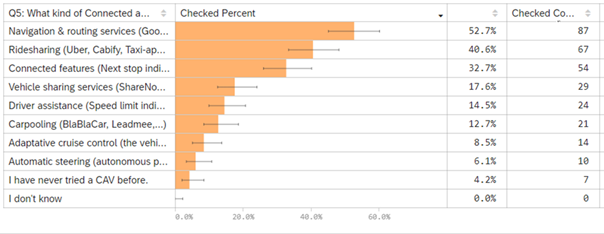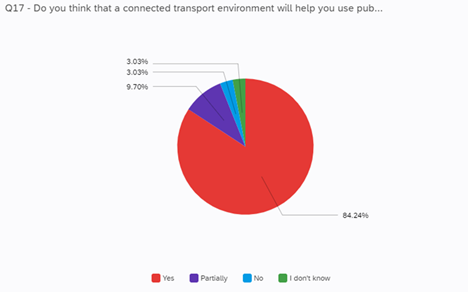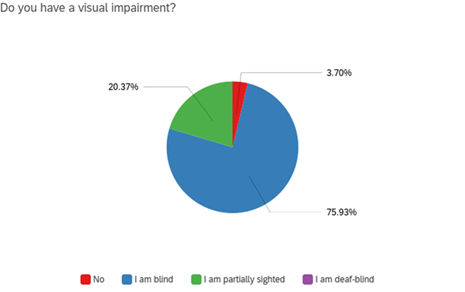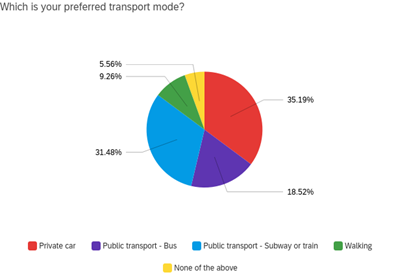
- Connected transports for inclusive cities
Conducted in Madrid and partly in Italy, the pilot project focused on the needs of vulnerable users in connected transport environments.
Following more than 6 months of implementing different activities, the pilot carried out in Madrid as part of the European project PAsCAL (Enhance driver behavior and Public Acceptance of Connected and Autonomous vehicLes) to assess the needs of inclusiveness and safety of vulnerable passengers who use autonomous and connected transport (see article on page 28 on Onda Verde n.34) has come to an end and the the team of experts who conducted it promptly analyzed the results, presenting them in a live streaming workshop whose documentation can be accessed on the facebook page of the PAsCAL project https://www.facebook.com/pascalprojecteu/.
In total, 4 distinct activities have ensured that this pilot looks into all possible aspects of the experience of vulnerable travellers in connected transport environments drawing relevant indications for the development of connected transport systems that allow full accessibility and facilitate the autonomy of users with visual and mobility limitations.
Apertum field testing:
The first and main activity consisted of testing a mobile application for step-free transport in Madrid, called Apertum. This application has recently received the Muévete Verde 2021 award of Empresa Municipal de Transportes de Madrid. The participants consisted of wheelchair users of Fundación Lesionado Medular - FLM, elderly persons of Nadiesolo and persons with temporary mobility constraints (such as carrying heavy luggage, suffering from a temporary leg injury or pregnant women) of Universidad Alfonso X El Sabio - UAX. They used the application to follow one of four different itineraries within the complex and connected Madrid transport system. The app recalculates common routing algorithms, such as Google Maps and removes all of the stops which are not fully accessible (for example those who are missing elevators or accessible ticket machines).
The results of the tests conducted in Madrid are summarised below.
A total of 165 participants participated in the test, who then answered a questionnaire which showed that the most often used CAV systems are (Table 1):
- Navigation & routing services;
- Ridesharing services;
- Integrated connected features.

Half of the participants said they rarely or never encounter obstacles on their journeys, while the other half reported that they face barriers to seamless transport sometimes or very often (Table 2)

Most of the participants (84% in total) think that a connected transport environment will help them use public transport independently, and 90% said that it is important for them to have a high autonomy in their daily mobility.

Although most of the users think connected transport environments will save them time (62%) or can possibly save them time (28%), less than half of the users (47%) are willing to pay for this type of service.
UI/UX testing:
A UI/UX testing of the same mobile application took place, involving one group of young participants (17-24 years of age) and one group of elderly participants (60-89 years of age).
The testing took 90 minutes in total and participants were asked to complete 4 different tasks within the app and were also given 30 minutes of open usage to explore the application. Thanks to the testing, it was possible to develop some concrete improvement suggestions for the Apertum app to make it even more accessible.
Stakeholder interview:
An interview was conducted in collaboration with the Spanish Road Association – AEC and with the regional Madrid Transport Authority, Consorcio Regional de Transportes de Madrid - CRTM. The organisation highlighted the importance of an intact basic transport infrastructure before adding elements of connectivity or automation to the mix.
Connected features do not directly increase the number of users of any transport system but renders it more attractive, which can lead to increased usage overtime. A major issue that delays the implementation of a totally connected transport environment are data ownership and financing of infrastructural investments to modernise parts of the public transport system. Currently, smart infrastructures such as intelligent occupancy measurements, real time management, separated bus lanes, autonomous buses and deterrent parking lots represent efforts of the operator to switch to a CAV-adapted environment.
Focus Discussion Groups with blind & partially sighted persons
Parallel to the tests carried out in Madrid, four separate Focus Discussion Groups s have been organised together with the European Blind Union - EBU Italian member, Unione Italiana dei Ciechi e degli Ipovedenti - UICI in Rome, Milan, Bologna and Naples. Almost all participants of these discussions were blind or partially sighted persons of various ages, professions, backgrounds and familiarity with CAVs. The main results highlighted by these focus groups are summarized below (Graph 2).

90% of the participants stated that being able to travel alone was very important to them, however only 22% of them are comfortable doing it in routes they do not know.

Compared to the participants in the main pilot, blind participants were more likely to travel in a private vehicle than in public transport, most commonly with subway and train.

Final Considerations
Following the execution of an array of different activities, it became clear that the terminology of a CAV is too abstract for communication with the general public – once the terminology was replaced with concrete examples or categories of CAV services (such as ridesharing or cruise control) and use-cases, participants were able to respond to the questionnaire with more ease.
Second, the pilot project indicated that navigation systems, ridesharing apps (uber, taxi apps…) and connected features such as the next stop indicator in buses were the most familiar CAV features to all participants. Autonomous features such as adaptative cruise control and automatic steering are the least tried features – it is therefore recommendable to enable more people to try and experience these features both as passengers and as drivers to familiarise them with features of higher levels of automation.
It is not rare that users find obstacles while traveling by means of public transport. The authors recommend obliging public transport operators to be obligated to display accessibility information on their transport environment publicly for a higher inclusivity level of the system.
It is vital that HMIs which are already onboard of CAVs today are equipped with more options to access or command the HMI using audio and voice activation. Furthermore, vehicles need to communicate with their environment using audio cues like signal sounds to ensure the safety of visually impaired persons in the CAV surroundings.
Another result to be carefully examined is that older citizens seem to be increasingly more tech-savvy and are more familiar with the usage of smartphones and computers than anticipated previously, most of them have been using them for over 5 years. It is therefore not sufficient anymore to recruit retired or elderly persons when a technology is to be checked for usability taking into account people who are not tech-savvy.
Finally, cities without an intact and modern basic transport infrastructure are recommended to invest first in improving the available infrastructure before spending additional money on rendering it connected or automated, such as tactile pavements, adapted ticket machines and wheel chair accessible platforms, trains and buses.
A final fact that emerged from the pilot that certainly deserves to be mentioned concerns, more generally, the concerns represented by the citizens involved in the survey in relation to the future dissemination of CAV. Many participants were in fact concerned about the dangerous integration of CAVs into regular traffic as well as ethical concerns when it comes to the decision making of a fully autonomous vehicle involving people with impairments or disabilities.